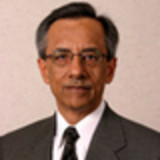“Let’s get her ready for surgery,” I said to the junior resident. We pushed the patient on a stretcher out of the radiology department.
The patient was a middle-aged, somewhat overweight woman who had presented to the ED with classic symptoms of cholelithiasis. Her physical examination was conclusive with a positive Murphy’s sign with right upper quadrant tenderness on deep inspiration. The blood work showed mild leukocytosis. The plain x-ray showed a partially calcified gallstone in the right upper quadrant.
At the time, I was a second-year surgical resident working in an acute care service at one of the busiest trauma hospitals in the U.S. My colleagues and I were always hoping for semielective procedures to give us a break from the onslaught of high-intensity cases, many of which involved gunshot and stab wounds.
But on our way to the surgical unit, the radiologic technologist suddenly came out of the imaging room and said: “Just wanted to let you know I felt this thing on the patient’s back as I was helping move her from the x-ray table to the stretcher. You may want to check it out.”
Thinking nothing of it at first, I felt the patient’s back and then turned her on her left side. Sure enough, there was a large 2-inch wart, or dystrophic calcification of the skin, located precisely where the gallstone would have appeared on a plain posterior-anterior x-ray film. A repeat lateral-decubitus x-ray exam showed no gallstones at all, contrary to the initial diagnosis. She did not undergo surgery but instead was discharged with medications for dyspepsia and antacids.
That was a lesson I learned early in my surgical training and never forgot — the importance of eye-balling and feeling parts of the body in question before making any decisions.
The lack of emphasis on physical examinations in the training of medical students and residents has been a problem in recent years. Poking, tapping, percussion, and sometimes even listening is often missing in clinical practice. Usually, there is a checklist of questions for physicians to ask, boxes to be checked, and a cursory exam to be performed over a patient’s clothes. Rarely are hands-on examinations performed beyond superficial auscultation of the heart and lungs.
In a 2017 survey of 2,684 internists from a wide range of countries, 70% of the internists regarded physical examination as “almost always valuable.” Yet in the same survey, nearly 67% of trainees claimed that their physical exams were never overseen by a consulting physician, and 31% indicated that they had never seen a consultant actually demonstrate any techniques. Before anyone unloads on younger physicians about their lack of skills in physical examination, it was the younger physicians in the same survey who found physical exams more valuable for patient assessment.
I certainly do not want to come off sounding like an old codger clinging to the physical exam as the be-all and end-all, minimizing the value of newer diagnostic tools such as CT, MRI, and PET scans.
However, it is obvious to me that the easy availability of new technology has de-emphasized physical examination from our armamentarium. At conferences, when a slide presentation of a patient case is unveiled, lab values and radiologic images are displayed but nominal attention is paid to the physical exam.
It is not expected for newer residents to be able to match past “giants” in medicine who were able to describe the exact degree of stenosis or incompetence of an aortic valve murmur with a standard exam. That skill is probably lost forever.
But the shift away from physical examination, where appropriate, is a sad commentary on the state of medicine. Physicians are always on the clock, like sports teams during a draft. One-size-fits-all 20-minute slots for patient visits are often enforced and monitored. The entire foundation of physician compensation at many institutions rests on “productivity” measured by work-related units, which were not originally designed for this function.
When ordering a test is quicker than a thorough physical exam and yields more revenue to the health care system, it comes as no surprise to see this change taking place. Is it time to take another hard look at our current system of training and reimbursement?
In the comment section below, share your experiences in which a physical exam helped improve clinical care.
Bhagwan Satiani, MD, MBA, RPVI, FACS, FACHE is professor of clinical surgery in the Division of Vascular Diseases & Surgery at Ohio State University College of Medicine.







